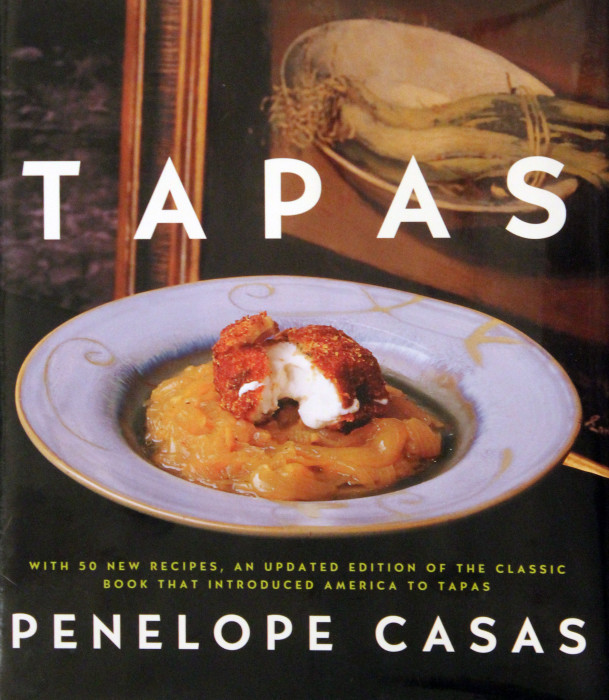This week’s Throwback Thursday cookbook review is a classic: Tapas by Penelope Casas. First published in 1985, and republished in 2007, Tapas was a breakthrough book. In 1985, how many of us knew what tapas was, or had ever sampled tapas at a restaurant? In fact, in 1985 in the United States, how many tapas restaurants were there?
Thirty years on, you can read about a new tapas spot opening somewhere in Manhattan every week. People, across the country and not just in Manhattan, throng to tapas bars. Just google “tapas restaurants” and then type in a first letter: say, “P.” You’ll see suggestions right then for the tapas spots in Philly, Portland, Phoenix and Providence. Any letter will do. Tapas has spread far and wide.
This book, Tapas, can make no small claim to the establishment and spread of the tapas trend. Not only was this the first major tapas book, it set a standard for tapas recipes that can be equaled but never surpassed. This was and remains the seminal book. Penelope is recognized as the foremost authority on Spanish food, and she does have other grand books like The Foods and Wines of Spain.
Yet Tapas remains something that is uniquely special. For Suzen and me, it sits on the “main” bookshelf, close at hand, always a resource to be treasured and enjoyed.
Tapas has four main chapters:
- Tapas in Sauce
- Marinades, Pates, Salads, and Other Cold Tapas
- Tapas with Brad or Pastry
- Tapas with Some Last-Minute Preparation
When you open the book to any of these chapters, you immediately see “new” delights that will trigger your salivary glands. For example, the Sauce’s chapter begins with Chickpeas in Onion Sauce, a dish to be prepared a day in advance to extract every molecule of onion sweetness and to give the chickpeas the time they truly need for flavor to blossom and texture to mature. Here you will also find Shrimp and Mushrooms in Almond Sauce. The “nut culture” of Spanish food is a grand tradition and here native almonds are matched with the seafood treats that so typify Spanish, and especially tapas, cuisine.
I cannot imagine a life without onions — although there are those who do not enjoy the punch that comes with each bite. Onions are a core ingredient in tapas foods. In the Marinades chapter, you seem to find onion on every page: Sweet and Sour Marinated Onions, Pearl Onions in Sherry Vinegar, Onion Marmalade, … Too often Americans simply cut an onion up for a salad or perhaps chop and sauté for a sauce or as a meat accompaniment. In Tapas, you see how onions can become “the dish” by giving them careful attention and focus.
In the Cold Tapas chapter, you will naturally find devotion to Spanish cheeses. And while a tapas table may simple present cheese from the farm, again you can spend some time and truly “prepare” the cheese for enjoyment: Goat Cheese in Crackly Caramelized Sugar and Soft‑Ripened Cheese with Pedro Ximenez Syrup. Tapas style is to take simple things — onions, other veggies, cheese, seafood — and both compliment and amplify the flavors with preparations that are often, but not always, simple. You can make your tapas cooking quick and fast or you can spend some time to achieve an extra level of dreamy flavors.
The Bread and Pastry chapter begins with my favorite: empanadas. The combinations in Tapas are ones you may not have encountered: Pork and Green Pepper, Scallops, Stewed Onion and Saffron, Onion Confit with Anchovy and Piquillo Peppers. Here these empanada recipes are a little less simple, a bit more complex, and ever so rewarding.
If you have a little less time, but still want a distinguished bread dish, then you can do the Creamed Blue Cheese with Brandy. Here a crusty bread is spread with blue cheese than has been mashed with brandy. Simple, powerful and to be relished.
The forward to the Last-Minute Preparation chapter offers you words of comfort. “Last minute” does not literally mean the dish has to be served immediately. It does mean that there is some frying or grilling or baking that completes the dish and you do want to serve it “soon” after that preparation. The dishes here require some effort and planning, but again the rewards are enormous. There are the Stuffed Olive Fritters: green olives stuffed with capers, anchovies and pine nuts and then batter fried in olive oil. It’s the Mediterranean Diet all in one dish. Or you can sample Chorizo Filled Dates in Bacon, Artichoke Hearts with Shrimp and Serrano Ham, or any of her classic croquettes.
Ah, croquettes. Healthy? Well, if you just do them once and a while, the damage cannot be too great. I’ve actually tried that argument on my doctor and she found it quite amusing, as she reached for her prescription bad.
Seriously, if you are going to do croquettes, then this is the book to sample from: Lobster and Chestnut, Monkfish and Lettuce, Chicken and Serrano Ham. No grand night of tapas can really be complete without just one, or two, of these treats.
The recipes in Tapas are timeless. That’s why the book is timeless and deserves a space on your bookshelf. If you are ever bored, ever craving something but do not know what, you’ll find it here in this book of Spanish treasure.

